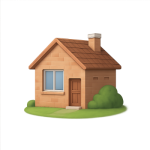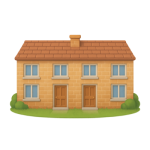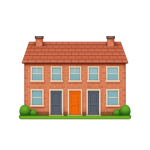Useful Links
Social
Cannock Property Prices: Local Insights You Can Use
Look at performance by housing category across Cannock’s districts, measured annually and aligned with external city data.
You’ll also see whether Cannock is experiencing balanced growth or isolated hotspots when viewed alongside local peers.
How much is your Cannock home worth?
Get a personalised estimate based on recent local sales and property type.
What Should Properties in Cannock Cost?
Property Type Breakdown
How big is the property?
Choose your comparison:
Cannock House Prices - Summary
An overview of house prices in Cannock since 2022.
House Prices > Cannock
| Year | Average Price | Transactions |
|---|---|---|
| 2025 (proj.) | £239,700 | 1,402 |
| 2024 | £230,200 | 976 |
| 2023 | £240,300 | 1,101 |
| 2022 | £232,900 | 1,542 |
| 2021 | £214,500 | 1,808 |
| 2020 | £207,300 | 1,366 |
| 2019 | £186,700 | 1,585 |
| 2018 | £181,600 | 1,435 |
The property market in Cannock has travelled a fascinating, sometimes unpredictable road since 2018. Price trends over these years reveal a market that is both resilient and quietly robust, even as the number of property sales has surged, dipped, then tentatively recovered. Each year seems to bring its own set of surprises - and opportunities - for buyers and sellers alike.
- Average prices have gently floated upwards for several years, peaking in 2023 before a minor dip in 2024, and are now projected to stabilise and slightly rebound in 2025.
- Transaction numbers painted a much more jagged picture. After a high in the late 2010s, volumes tumbled in 2020 (think of market activity slowing down like cars on a foggy morning along the A5), briefly recovering, then drifting lower again through 2023 and 2024. Yet, there’s optimism for a moderate rise in transactions heading into 2025.
- These subtle changes, while not seismic, mean that Cannock retains a certain underlying confidence - house prices have not crashed, and even the quieter years suggest more of a pause for breath than a sign of deep trouble.
What stands out is how, even in the face of occasional market headwinds, Cannock continues to offer a sense of security and long-term stability. For local families eyeing a move, or investors seeking a safe haven, this pattern can feel reassuring. The modest upticks in prices, alongside slower transaction activity, suggest a community that is attractive but not frenzied - demand remains, yet supply is selective. The market can feel as tight as the queue at Cannock Chase's ice-cream van on a balmy Sunday.
Looking to dig deeper into what shapes Cannock’s property values? Check out our feature: What’s Driving Property Values in Cannock?
Emphasised Key Insight
Despite a slower 2024, Cannock’s average property value has soared by over £58,000 since 2018 - a trend that proves its steady, enduring appeal for buyers across the region.
Want to get a proper feel for Cannock prices? Begin by browsing houses for sale in Cannock using our platform.
How Property Type Affects House Prices in Cannock

Detached
Avg. Property Price: £326,300
Avg. Size of Property
1,194 sq/ft
Avg. Cost Per Sq/ft
£282 sq/ft
Total transactions
785 (since 2021)

Semi-detached
Avg. Property Price: £196,000
Avg. Size of Property
848 sq/ft
Avg. Cost Per Sq/ft
£238 sq/ft
Total transactions
1,214 (since 2021)

Terraces
Avg. Property Price: £163,500
Avg. Size of Property
761 sq/ft
Avg. Cost Per Sq/ft
£220 sq/ft
Total transactions
528 (since 2021)

Apartments
Avg. Property Price: £107,500
Avg. Size of Property
598 sq/ft
Avg. Cost Per Sq/ft
£183 sq/ft
Total transactions
100 (since 2021)
Cannock’s property market paints a fascinating, sometimes surprising, picture when you break it down by property type. The pricing stratification largely follows expectations, with detached homes topping the charts, yet some rapid-fire growth seems to be quietly at play in segments that are not so high profile. If you are hoping for fireworks in the data, look closely: here, the changes are more like a creeping vine than a sudden bloom.
Detached properties command the highest costs, not just in headline price, but also per square foot. A significant part of their appeal comes from that expansive living space. But, with that said, forking out for extra square footage here is not just about comfort, it is about a perceived lifestyle leap. Is it all justified? That depends on your appetite for a larger plot and whether you view the cost per sq/ft as solid value or a luxury premium.
The semi-detached sector offers a compelling midpoint. Semi-detached properties see the highest transaction volume since 2021, which hints at a strong and steady demand for practical, mid-sized family homes. The market here looks animated, possibly because these homes balance space and price with a finesse that suits the majority of buyers who want neither minimalism nor maximalism. Yet, does the appetite for these homes reveal a broader anxiety about stretching the budget for something bigger? Or perhaps it’s just a love for reliability over grandeur.
If we wander down the property ladder to terraced houses, value-seekers will nod approvingly. Terraced homes in Cannock might not give you sweeping lawns, yet the modest cost per sq/ft and healthy transaction count signals a quietly resilient corner of the market. Are they the hidden heroes? In rapidly growing Midlands towns, they often are. For those searching out pockets of value, explore where affordable homes might still be found locally.
Flats are a minority sport here, with a notably lower transaction total. A compact average size and less daunting total price put them within reach for solo buyers, yet their presence feels almost muted compared to houses. Are local buyers holding out for freehold, or are flats simply less desirable in a town where green space comes more easily than in Birmingham or Manchester? Nobody is queueing round the block.
So, what should we remember?
- Detached homes pack in space and privacy, yet come at a premium that only buyers with deeper pockets can rationalise as long-term value.
- Semi-detached houses pulse with activity - steady as a Staffordshire canal - and remain the stalwart for families and upwardly-mobile locals.
- Terraced homes offer flexibility and affordable entry points, their reliability quietly ticking along beneath the market noise.
- Flats remain niche financially accessible, but rarely the first pick for those ingrowing roots locally.
Is Cannock following regional trends or quietly writing its own rules? The answer is perhaps a bit of both. For those wanting to peel back what is powering Cannock’s changing values, see What’s Driving Property Values in Cannock?
Cannock Property Prices by Local Area
| District | Avg Price (£) | Transactions |
|---|---|---|
| WS11 | £209,800 | 5,072 |
| WS12 | £213,700 | 4,800 |
Cannock has always been a place of quiet surprises, and nowhere is that more plain than in its property prices, which have been bouncing around like a rubber ball in a small room. The town’s two stand-out postcode areas, WS11 and WS12, both tell distinct but interconnected stories for buyers and sellers.
WS11 is a hive of activity. Its colourful mix of property styles attracts a staggeringly high number of transactions each year-neighbourhoods buzz with moves, upgrades, and first steps onto the ladder. There is clearly a thriving market here, and family homes have become the heartbeat of the area. The price tag is accessible enough to draw a wide range of buyers-people looking for their first home, growing families wanting a bit of garden and breathing space, or even those after a character-packed terrace on a peaceful lane.
Hop across neighbouring streets into WS12 and buyers notice a subtle but meaningful shift. Here, the average property commands a slightly plumper price, hinting at stronger demand, more desirable stock, or perhaps a touch of local prestige. Yet, it’s not all about glitz-the transaction numbers suggest less frantic activity compared to WS11. It feels calmer, more settled, perhaps reflecting leafy developments or established family homes that rarely hit the open market.
For buyers wanting to balance price and popularity, WS11 offers the wider pick, while WS12 tempts those who fancy a quieter scene, possibly with a dash more exclusivity. If you’re hunting for districts where value and desirability intertwine, you’ll find plenty of food for thought in our guide to Cannock’s great value homes.
So what’s the core message?
- WS11 is the engine room of Cannock sales, fuelled by choice, lively turnover, and inclusive pricing.
- WS12 brings a softer rhythm, offering slightly higher values, quieter streets, and homes that don’t change hands as frequently.
- If finding the sweet spot between price, lifestyle and activity is top of your agenda, focusing your search by district could make a major difference.
Property Prices in Cannock vs the Rest of the Region
| City | Avg Price (£) | Transactions |
|---|---|---|
| Burntwood | £232,800 | 2,785 |
| Rugeley | £232,900 | 3,168 |
| Walsall | £199,700 | 14,170 |
| Willenhall | £169,500 | 3,682 |
| Lichfield | £319,300 | 5,384 |
| Stafford | £246,500 | 11,288 |
| Wolverhampton | £207,500 | 18,880 |
| Wednesbury | £160,500 | 3,077 |
| Bilston | £160,000 | 3,271 |
| West Bromwich | £180,200 | 3,716 |
In Cannock and its diverse patchwork of neighbouring towns, property prices create a vivid spectrum. Local prices neatly balance between accessibility and aspiration, placing Cannock right in the sweet spot for many aspiring homeowners.
It’s impossible to ignore the sheer spread in values just down the road. The elevated elegance of Lichfield stands head and shoulders above the pack, carving out its place as a clear premium destination. Over in Stafford and Burntwood, a sense of security prevails. Homeowners here enjoy that classic, leafy-suburb feel without crossing into luxury pricing.
Then, look towards Walsall, Willenhall, and Bilston. Values in these areas feel much more approachable, with prices that open the doors to those keen to climb the first rung. For many younger buyers, these locations are especially popular. West Bromwich, too, tempts with its blend of affordability and urban convenience, all wrapped up in a town with character as mighty as the Hawthorns on match day.
What do the numbers truly hint at? A few key themes stand out:
- Prestige hot-spots: Lichfield’s leafy boulevards come with a fittingly hefty price tag, creating an air of exclusivity that’s tough to match nearby.
- Popular, practical pivots: Areas like Stafford and Burntwood offer an attractive middle ground. Prices are within reach for growing families, but still high enough to maintain desirable neighbourhood vibes.
- Accessible options for new movers: Willenhall, Wednesbury, and Bilston are ripe with potential for anyone who wants a step onto the ladder without overstretching. These places are friendlier on the wallet and never short of bustling local activity.
- Cannock’s local flavour: Sitting confidently in the centre of the price mix, Cannock offers a blend of lifestyle, value, and strong community energy. It’s the kind of place where high street shops still thrive, and where word of mouth matters as much as flashy brochures.
So, what should we remember?
- Cannock provides a steady middle ground, appealing to a wide range of buyers looking for good value and real local spirit.
- Premium locations like Lichfield shine brightest for those seeking status or gorgeous period homes.
- Neighbouring budget-friendly spots open the market to more people, making it easier for both first-timers and seasoned movers to find their place.
- The area’s lively mix means housing choice is as vibrant, bold and varied as a bustling Cannock market morning.
Property fortunes here speak not just of prices, but of lifestyle, community, and the distinctive character that makes this patch of the Midlands unique.
Quick note: this comparison uses average property prices and transaction numbers only.
Property size and cost per square foot are not factored in, meaning some shifts may be missed. To explore further, visit our blog.
Trusted Foundations. Transparent Outcomes.
Housing data is complex. We untangle it through soft recalibrations and a flexible model that brings every valuation closer to real life. Trace the thinking behind our model

